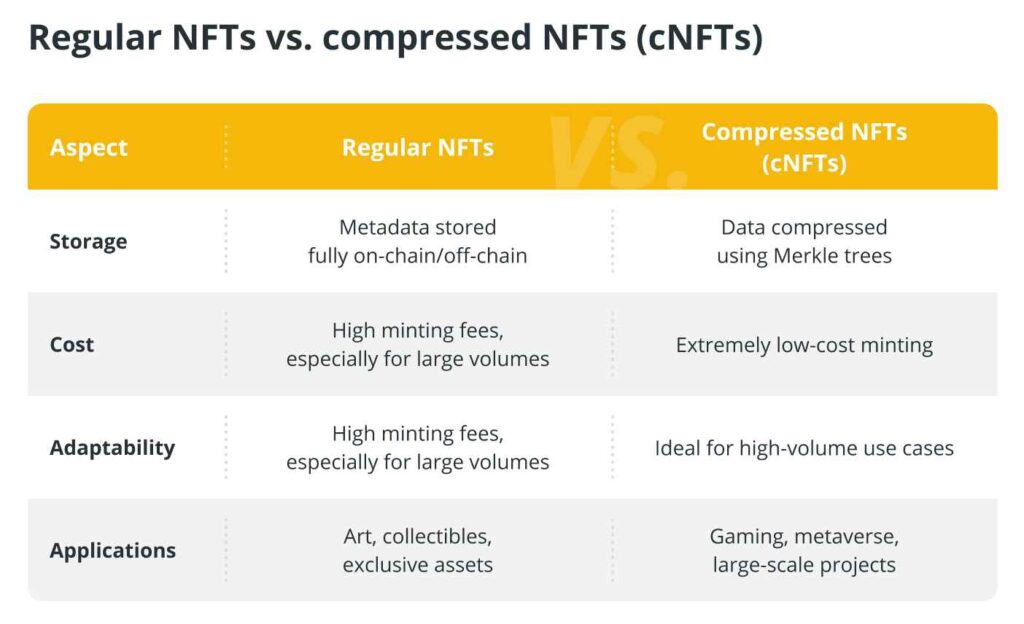Compressed NFTs (cNFTs) represent an innovative evolution in the realm of non-fungible tokens, designed to reduce storage and minting costs on the Solana blockchain. As the demand for NFTs grows, developers face challenges in managing the costs associated with creating and storing these digital assets. Solana introduced cNFTs as a solution to these issues, leveraging state compression technology to optimize data efficiency.
What Are Compressed NFTs?
Compressed NFTs utilize state compression, a method that significantly reduces the storage footprint of NFTs. Unlike traditional NFTs, which store all metadata directly onchain or via external links (such as IPFS), cNFTs use Merkle trees to consolidate and compress data.
To put it simply, regular NFTs maintain individual onchain records for ownership and metadata. In contrast, cNFTs aggregate these records into a compressed format, which reduces storage costs and accelerates transaction processing.
Despite being a relatively new technology, compressed NFTs have quickly gained traction, accounting for a substantial portion of the NFTs minted on Solana today.
Key Features and Benefits of Compressed NFTs
Compressed NFTs are designed for scalability and cost-efficiency, making them ideal for large-scale applications. Here are their standout features:
- Cost Efficiency
Minting cNFTs costs a fraction of what traditional NFTs require. For example, creating 1 million regular NFTs can cost upwards of 24,000 SOL using conventional methods. With cNFTs, the same operation could cost as little as 10 SOL. This makes cNFTs particularly attractive for projects that require high-volume NFT minting, potentially reducing costs by over 1,000x. - Scalability
cNFTs are tailored for applications like gaming, social media, and the metaverse, where thousands or even millions of NFTs may be required. Their ability to handle large volumes of tokens seamlessly is a game-changer for developers. - Hybrid Storage Model
cNFTs combine the best of onchain and offchain storage. Ownership data is maintained onchain, ensuring security and authenticity, while metadata is stored offchain, reducing costs without compromising functionality. - Eco-Friendly
By reducing storage requirements, cNFTs consume less energy, making them a greener alternative compared to traditional NFTs. This aligns with broader efforts to create more sustainable blockchain technologies.

cNFTs vs Traditional NFTs
While both cNFTs and traditional NFTs serve the purpose of tokenizing digital assets, their use cases differ significantly:
- Traditional NFTs: Best suited for unique, high-value assets like exclusive digital art or collectibles. These tokens typically store all metadata onchain or in a robust external system, which can be expensive and resource-intensive.
- Compressed NFTs: Designed for scenarios that demand high scalability and affordability. They excel in distributing gaming assets, metaverse items, or digital collectibles to millions of users.
Key Differences
| Aspect | Traditional NFTs | Compressed NFTs |
|---|---|---|
| Storage | Onchain or external | Onchain (ownership) + Offchain (metadata) |
| Cost | High | Low |
| Ideal Use Cases | Rare, unique items | High-volume applications |
| Scalability | Limited | High |

How to Mint Compressed NFTs: A Quick Guide
Although minting cNFTs may seem complex, modern platforms simplify the process. Here’s a general step-by-step guide:
- Set Up a Wallet
Use a Solana-compatible wallet such as Phantom or Solflare to manage funds and interact with blockchain tools. - Fund Your Wallet
Add SOL, Solana’s native cryptocurrency, to cover minting costs. The efficiency of cNFTs ensures that even small amounts are sufficient. - Choose a Minting Platform
Platforms like Metaplex, Candy Machine, and Crossmint support cNFTs. Select one based on your project’s scale and features. - Prepare Metadata
Define the details of your NFT collection, including artwork, descriptions, attributes, and other metadata. Use decentralized storage solutions like IPFS for offchain data. - Mint and Organize with Merkle Trees
Most platforms automate the process of setting up Merkle trees for compressed data. Follow the platform’s instructions to mint your cNFTs. Confirm transactions through your wallet, and your cNFTs will go live.
Where Are Compressed NFTs Stored?
cNFTs employ a hybrid storage model:
- Onchain: Ownership data and the Merkle root are stored securely on the blockchain.
- Offchain: Detailed metadata, such as images or attributes, is stored in decentralized systems like IPFS.
This approach reduces onchain storage needs while maintaining asset integrity and accessibility. By keeping critical data onchain and larger metadata files offchain, cNFTs achieve a balance between cost savings and utility.
Why Choose Compressed NFTs?
Compressed NFTs represent a significant advancement in NFT technology. Their ability to drastically lower costs and scale efficiently opens doors for creators, developers, and businesses to explore blockchain applications without financial barriers.
With their eco-friendly design and hybrid storage approach, cNFTs pave the way for innovative use cases, particularly in high-volume industries like gaming, social media, and the metaverse. As adoption grows, cNFTs are poised to become a cornerstone of scalable, affordable, and sustainable blockchain solutions.















Leave a comment